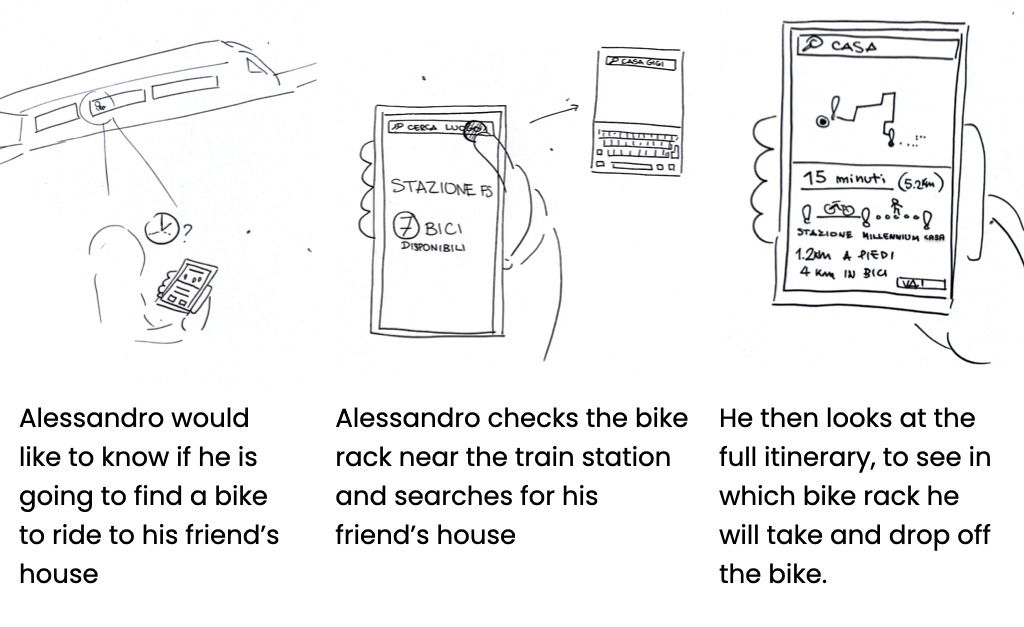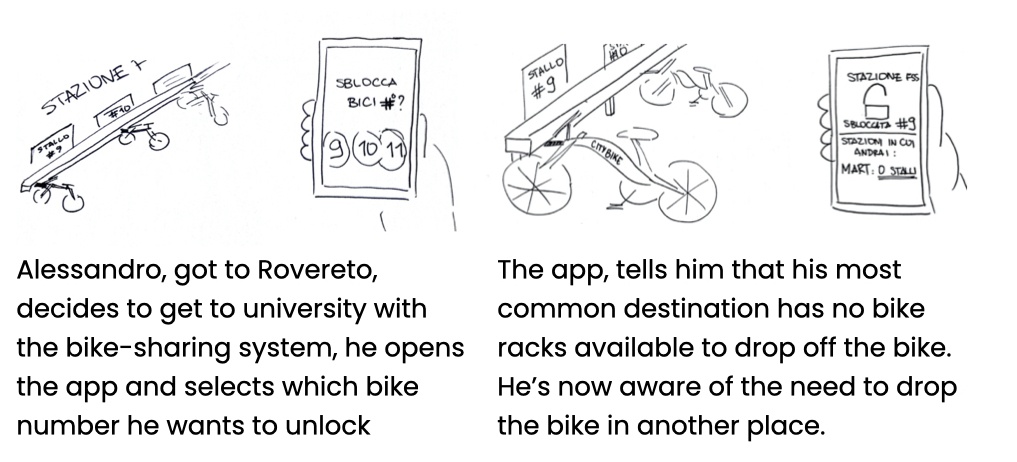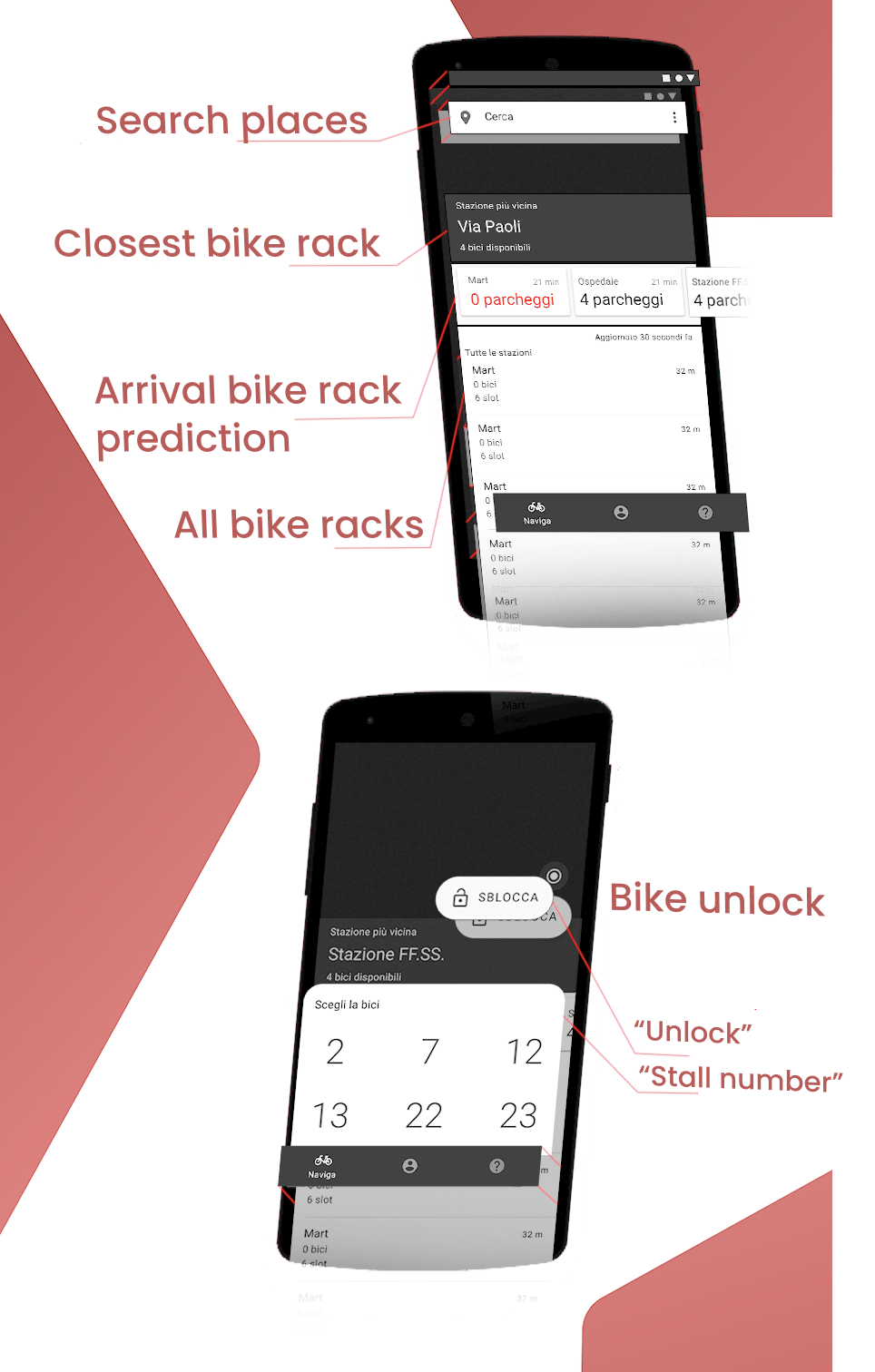“Develop and Android app that supports citizens in the use of Trento’s bike-sharing system.”
Introduction
The city of Trento (Italy) developed a public bike-sharing system with fixed bike racks. This project is focused on redesign the current experience that could support the citizens in the use of this infrastructure.
The team
Giona Fossati
Research and Ideation, Interaction Design
Process & Learning Goals
The process we followed is the one defined, by Alan Cooper, as Goal-Directed Design. Hence, we designed focusing on the users’ goals, motivations, and current use of the system.
The approach was based on the British Design Council's Double-Diamond (Figure 1).
For this purpose, we built our custom Trello board to keep track of the project development and outline the process we followed.
To develop our knowledge about the use of design systems and keep the UI familiar and coherent throughout the app, we purposely used Material Design guidelines by Google.
End Results
Before
After
End Results
Before
After
Section 1: Grounding
In the first phase, we pursued a bottom-up approach: we started defining the Vision and our Winning Proposition. We explored the service's website to gather informations about the subscription model: the service costs 35€/year with the first 30-minutes of rent for free.
Vision
Allow users to get from point A to point B with the least effort possible. Provide additional value to the user: help before and during the use of the service.
Winning Proposition
Achieve business objectives, such as the amelioration of the service, increased market competitiveness, and innovation of the service.
Stakeholder Analysis
We focused our efforts on understanding the possible concerns and fears of our stakeholders. This because, while the benefits of digitalizing a service are straightforward, the main obstacle to the adoption and use of this kind of app relies on the fears of his main stakeholders.
Bicincittà (The Company)
Primary Stakeholder
- Fear of change & innovate
- Hidden costs
- Solution scalability
Customer Care
secondary Stakeholder
- Increase in the number of reports and requests of help
- Fear of being replaced by automation
- Fear of new technologies
Bicincittà (The Company)
Primary Stakeholder
- Fear of change & innovate
- Hidden costs
- Solution scalability
Customer Care
secondary Stakeholder
- Increase in the number of reports and requests of help
- Fear of being replaced by automation
- Fear of new technologies
Domain's Objects & Processes
To get a better understanding of the context in which the application would work we carried out an analysis of the different objects and processes that are required for the service to work. This activity helped us to understand the knowledge required for the users to use the service.
DESCRIPTION
PROPERTIES
Bike Rack
object
Fixed point in which users are able to pick up and drop off a bike.
- Position
- Distance from user
- Purpose (pick up/drop off)
Bike Stall
object
Individual place in which a single bike can be attached to. Has a led displaying its status.
- Stall number
- State (Functioning/Malfunctioning)
- Availability (Taken/Free)
Bike
object
Bike provided by the service
- Type (Classic/Electric)
- State (Available/Malfunctioning)
Card
object
NFC Card that allows to pick up a bike, is linked to other local services such as transport and local services.
- Card Number
Pick up
process
Process in which the user unlocks the bike through his card. Can be difficult for less strong users. Status is displayed by a led.
- Status (Successful/Fail)
Drop off
process
The user locks the bike by placing a bike extrusion into the stall. Status is displayed by a led.
- Status (Successful/Fail)
The ride
process
Single use session. Starts with the Pick up at a Bike Rack, then the Ride and ends with the Drop off in a Bike Rack. First hour is free.
- Duration
- Path
- Pick Up and Drop Off
- Cost
Malfunction Report
process
Process in which the user reports a bike malfunction to the support.
- Bike ID
- Bike location
- Malfunction Type
Bike Rack
object
DESCRIPTION
Fixed point in which users are able to pick up and drop off a bike.
PROPERTIES
- Position
- Distance from user
- Purpose (pick up/drop off)
Bike Stall
object
DESCRIPTION
Individual place in which a single bike can be attached to. Has a led displaying its status.
PROPERTIES
- Stall number
- State (Functioning/Malfunctioning)
- Availability (Taken/Free)
Bike Stall
object
DESCRIPTION
Individual place in which a single bike can be attached to. Has a led displaying its status.
PROPERTIES
- Stall number
- State (Functioning/Malfunctioning)
- Availability (Taken/Free)
Bike
object
DESCRIPTION
Bike provided by the service
PROPERTIES
- Type (Classic/Electric)
- State (Available/Malfunctioning)
Pick-up
process
DESCRIPTION
Process in which the user unlocks the bike through his card. Can be difficult for less strong users. Status is displayed by a led.
PROPERTIES
- Status (Successful/Fail)
Drop off
process
DESCRIPTION
The user locks the bike by placing a bike extrusion into the stall. Status is displayed by a led.
PROPERTIES
- Status (Successful/Fail)
The ride
process
DESCRIPTION
Single use session. Starts with the Pick up at a Bike Rack, then the Ride and ends with the Drop off in a Bike Rack. First hour is free.
PROPERTIES
- Duration
- Path
- Pick Up and Drop Off
- Cost
Malfunction Report
process
DESCRIPTION
Process in which the user reports a bike malfunction to the support.
PROPERTIES
- Bike ID
- Bike location
- Malfunction Type
Grounding: learnings
Defining our main business stakeholders' fears helped us focus, not just only on the usability side of the application, but also on prioritize the features that would encourage the stakeholders to adopt our solution. Analyze the domain's objects and processes became useful to delineate the basic interactions we had to design in our application during the Ideation phase.
Overall, understanding the environment in which our solution would be placed helped us in the following phase: framing the user's problems.
Section 2: Problem Framing
We spent a morning interviewing users near different bike racks throughout the city. We mixed the story interview technique to the Contextual Inquiry methodology (Beyer & Holtzblatt) to get insights about the users' primary goals, knowledge and current use of the service. The findings have been synthesized in multiple personas.
Personas
Alessandro
persona hypotesis
33 years old
💼 Tourist
🚲 Primary mean of transportation
🕐 10/60 minutes rides
🗺 2/7 km rides
goals
- Save time commuting
- Save money for transportation
- Substitute car to other means of transportation
- Looking for more commodity then walking
- Be indipendent in the everyday commute
Story
Daily regular usage, he uses the bike-sharing mainly to get from the train station to university. He checks the bike rack’s availability with a glance; when no bikes are available, he continues by foot and checks the next bike racks on his way.
Sometimes he doesn’t drop off the bike correctly so he has to contact the customer support; because of this, he often checks his profile to see if he correctly locked the bike. He often struggles to get in contact with the support when the bike doesn’t unlock with the card.
Giovanni
primary persona
38 years old
💼 Employee
🚲 Primary mean of transportation
🕐 30/40 minutes rides
🗺 8/9 km rides
goals
- Commute home-work in a pleasurable & healthy way
- Be on time
- Save time, energy & money
- Do some physical exercise
- Avoid traffic jams
Story
Daily regular usage, it’s his primary mean of transportation during the working days. He rarely uses the bike after the 30-minutes free window. He finds the bike-sharing service handy because it’s cheaper than buying and owning an electric bike. He’s familiar with the location of every bike rack on his path, but he’s unaware of the other racks throughout the city.
When doesn’t find a bike, he walks to the next bike rack on his path looking for it.
He often finds himself in the need of change bike due to malfunctions: the electric one, when it’s out of battery or the engine doesn’t work; the analogic bike, when he spots and electric bike on his way to work.
To be sure he doesn’t run out of money, he usually tops-up his profile with some extra euros and he checks often his past rides.
He gets in touch with customer support when the bike doesn’t unlock. When he experiences a malfunction he usually, not always, reports it, with some difficulty, to the customer support.
Alessandro
primary persona
22 years old
💼 Student
🚲 Primary mean of transportation
🕐 15/20 minutes rides
🗺 2/5 km rides
goals
- Save time commuting
- Save money for transportation
- Substitute car to other means of transportation
- Looking for more commodity then walking
- Be indipendent in the everyday commute
Story
Daily regular usage, he uses the bike-sharing mainly to get from the train station to university. He checks the bike rack’s availability with a glance; when no bikes are available, he continues by foot and checks the next bike racks on his way.
Sometimes he doesn’t drop off the bike correctly so he has to contact the customer support; because of this, he often checks his profile to see if he correctly locked the bike. He often struggles to get in contact with the support when the bike doesn’t unlock with the card.
Giovanni
primary persona
38 years old
💼 Employee
🚲 Primary mean of transportation
🕐 30/40 minutes rides
🗺 8/9 km rides
goals
- Commute home-work in a pleasurable & healthy way
- Be on time
- Save time, energy & money
- Do some physical exercise
- Avoid traffic jams
Story
Daily regular usage, it’s his primary mean of transportation during the working days. He rarely uses the bike after the 30-minutes free window. He finds the bike-sharing service handy because it’s cheaper than buying and owning an electric bike. He’s familiar with the location of every bike rack on his path, but he’s unaware of the other racks throughout the city.
When doesn’t find a bike, he walks to the next bike rack on his path looking for it.
He often finds himself in the need of change bike due to malfunctions: the electric one, when it’s out of battery or the engine doesn’t work; the analogic bike, when he spots and electric bike on his way to work.
To be sure he doesn’t run out of money, he usually tops-up his profile with some extra euros and he checks often his past rides.
He gets in touch with customer support when the bike doesn’t unlock. When he experiences a malfunction he usually, not always, reports it, with some difficulty, to the customer support.
Elisa
SECONDARY persona
63 years old
💼 Retired
🚲 Primary mean of transportation
🕐 10 minutes to 1.5 hour rides
🗺 2/3 km rides
goals
- Commute independently in the city centre
- Save energy
- Be independent in the daily errands
- Do physical exercise
- Avoid distress of public transportation
Story
She uses the service weekly to get around the city to go meet his relatives or to go shopping. She uses multiple bike stalls, the most common is the closest to his house that often finds without free bike stalls.
She uses the bikes multiple times for short distances. If she doesn’t find any free stall, she doesn’t mind keeping the bike for a longer time. She feels insecure driving, and thus, the bikes are a good alternative to the car.
In good weather, she loves to lengthen his ride or take on purpose the bike to experience the weather.
Although she always makes sure she drops off the bike correctly, it occurred multiple times that she needed to call the customer service because, due to the undetected lock, she ran out of credit.
When she has to go to a new place, she uses the map printed on the bikes’ rack totem to locate the rack closes to his destination.
Persona Hypotesis
During the research phase, we interviewed the sales manager of Bicincittà and some of the customer's support operators. From our understanding of their business goals and their plans for the digital transformation of their services, we decided to build a persona hypothesis, that doesn't represent any of the users we interviewed but, that would depict the user that the company would like to acquire in the future.
Daniel
persona hypotesis
33 years old
💼 Tourist
🚲 Primary mean of transportation
🕐 10/60 minutes rides
🗺 2/10 km rides
goals
- Visit every corner of Trento
- Move rapidly
- Don't waste time
Story
Daniel is a German tourist in Trento with his wife for a 3-days leisure trip. He needs to find a means of transport in a city where he will stay temporarily. Spending some extra money is not a concern, his primary goal is to find a way to visit the city without wasting the limited time he has.
He knows some words in Italian but he's not able to understand full sentences. He will use the bike stall near the most touristic places, at every time of the day.
Given his scarce knowledge of the city, he will often check the map during his ride. His phone battery will drain at twice the normal speed. During his ride, he will often stop to take photos, make stories, and rest.
Since Daniel's goals were based on assumptions, we took them into consideration during the ideation phase but they didn't influence design decisions on a wide scale.
Pain Points Matrix
From the research we did, we were able to elicit the current pain points the users experience during the use of the service. We created a matrix that would allow us to understand which pain points are shared by most of our personas: this helped us to prioritize the problems that needed to be solved.
Alessandro
Student
Giovanni
eMPLOYEE
Elisa
Retired
Daniel
Tourist
Alessandro
Student
Elisa
Retired
Giovanni
eMPLOYEE
Daniel
Tourist
Alessandro
Student
Giovanni
eMPLOYEE
Elisa
Retired
Daniel
Tourist
Pain Points shared by all 4 personas:
1. Finding the arrival bike rack without any free stall
2. Not having the card to unlock the bike
Pain Points shared by all 4 personas:
1. Finding the arrival bike rack without any free stall
2. Not having the card to unlock the bike
Pain Points shared by 3 personas:
3. Not finding the bike at the initial bike rack
3. Not finding the bike at the initial bike rack
4. Going to a new place
4. Going to a new place
5. Keep track of the account’ balance
5. Keep track of the account’ balance
6. Not exceeding the free 30 minutes
6. Not exceeding the free 30 minutes
7. Calling the customer support
7. Calling the customer support
Pain Points shared by 2 personas:
8. Not finding the main office’s address
8. Not finding the main office’s address
9. Having the bike racks too far from his points of interest
9. Having the bike racks too far from his points of interest
10. Finding the bike difficult to unlock
10. Finding the bike difficult to unlock
11. Unlocking a malfunctioning bike
11. Unlocking a malfunctioning bike
12. Wasting time reporting a malfunction
12. Wasting time reporting a malfunction
13. Not dropping off the bike correctly
13. Not dropping off the bike correctly
14. Understanding how far is their destination rack
14. Understanding how far is their destination rack
15. Knowing the path to take while riding
15. Knowing the path to take while riding
Pain Points shared by 1 persona:
16. Not knowing the service’s terms and conditions
16. Not knowing the service’s terms and conditions
17. Not being able to switch the bike due to the bike rack being full
17. Not being able to switch the bike due to the bike rack being full
18. Knowing if the service is available in other cities
18. Knowing if the service is available in other cities
19. Getting information in another language besides Italian
19. Getting information in another language besides Italian
Section 3: Ideation
Features-Solutions Table
Time to converge to solutions, we took the first 15 pain points – which had 2 or more personas sharing the same problem – for each of them we tried to envision the possible solutions: hence, we obtained our features ordered by implementation priority. This table represented the blue print on which we then based the app's information architecture (IA) and the features' visibility in the app.
Pain POint
Feature
Solution
Pain POint
Feature
Solution
1. Finding the arrival bike rack without any free stall
Arrival bike rack prediction
The app notifies if the predicted arrival rack, based on the previous rides, is full
1. Finding the arrival bike rack without any free stall
Arrival bike rack prediction
The app notifies if the predicted arrival rack, based on the previous rides, is full
2. Not having the card to unlock the bike
Unlock
The user is allowed to unlock the bike through the app
2. Not having the card to unlock the bike
Unlock
The user is allowed to unlock the bike through the app
3. Not finding the bike at the initial bike rack
Nearest bike rack position
The app, when the user doesn't have an active ride, suggests the nearest bike rack with bikes available
3. Not finding the bike at the initial bike rack
Nearest bike rack position
The app, when the user doesn't have an active ride, suggests the nearest bike rack with bikes available
4. Going to a new place
Search/directions
The app allows user to search and get directions to a place: departure and arrival bike racks, and journey on foot included.
4. Going to a new place
Search/directions
The app allows user to search and get directions to a place: departure and arrival bike racks, and journey on foot included.
5. Keep track of the account’ balance
Account balance
The user can check the current balance from the app
5. Keep track of the account’ balance
Account balance
The user can check the current balance from the app
6. Not exceeding the free 30 minutes
Ongoing ride controls
Once a bike is unlocked, a timer that displays the riding time appears
6. Not exceeding the free 30 minutes
Ongoing ride controls
Once a bike is unlocked, a timer that displays the riding time appears
7. Calling the customer support
In-app support
The user can contact the support via the app, without calling.
7. Calling the customer support
In-app support
The user can contact the support via the app, without calling.
8. Not finding the main office’s address
"About the service" section
An app section will be dedicated to group all the administrative information about the service
8. Not finding the main office’s address
"About the service" section
An app section will be dedicated to group all the administrative information about the service
9. Having the bike racks too far from his points of interest
Send suggestions
The app allows the user to send specific suggestion for possible racks' locations
9. Having the bike racks too far from his points of interest
Send suggestions
The app allows the user to send specific suggestion for possible racks' locations
10. Finding the bike difficult to unlock
Multiple unlocks dialogs
When the user tries multiple times to unlock the bike, the app shows a dialog that displays the correct maneuver to unlock it.
10. Finding the bike difficult to unlock
Multiple unlocks dialogs
When the user tries multiple times to unlock the bike, the app shows a dialog that displays the correct maneuver to unlock it.
11. Unlocking a malfunctioning bike
Malfunctions Warning
The app warns the user for bikes that can possibly be malfunctioning. In case of low temperatures, it suggests not to use electric bikes.
11. Unlocking a malfunctioning bike
Malfunctions Warning
The app warns the user for bikes that can possibly be malfunctioning. In case of low temperatures, it suggests not to use electric bikes.
12. Wasting time reporting a malfunction
Pre-filled malfunction report
The report can be sent through the app: it automatically pre-compiles the bikes info and guides the user to report the problem.
12. Wasting time reporting a malfunction
Pre-filled malfunction report
The report can be sent through the app: it automatically pre-compiles the bikes info and guides the user to report the problem.
13. Not dropping off the bike correctly
Account balance
The user can check the current balance from the app
13. Not dropping off the bike correctly
Account balance
The user can check the current balance from the app
14. Understanding how far is their destination rack
Unlock
The user is allowed to unlock the bike through the app
14. Understanding how far is their destination rack
Unlock
The user is allowed to unlock the bike through the app
15. Knowing the path to take while riding
Account balance
The user can check the current balance from the app
15. Knowing the path to take while riding
Account balance
The user can check the current balance from the app
Storyboards
After ideating specific solutions based on the pain points, we brainstormed how we imaged the application, and its main features would work in the real environment. Thus, we sketched some storyboards that envisioned our personas using the application. This was useful for the team, it helped us clarify and communicate to each other were the project was heading to.
Designed Features
We decided to group the designed features in 3 different sections, based on the semantic relationships between them: Navigation, Profile, and Customer Support ("Assistenza"). Below you can see how we structured the Navigation screen to best support the user during his ride.
Interactive Prototype
We built an interactive prototype using Sketch and Invision, it demonstrates how we expect the application to work once developed. The bottom bar allows to navigate trought the three sections and interact with the features we designed.
Interactive Prototype
We built an interactive prototype using Sketch and Invision, it demonstrates how we expect the application to work once developed. The bottom bar allows to navigate trought the three sections and interact with the features we designed.
Final Takeaways
With this project, we had the ambition of ameliorating the experience of one important touchpoint for the Trento's bike-sharing users: during the process, I understood that, although one touchpoint can be optimized, is the overall service's quality – consisting of different physical and digital touchpoints – that plays a key role in delivering to the users a high-quality experience. Our intervention focused on one of the many touchpoints that are part of Trento's bike-sharing service: a more holistic approach should include diving deeper into the customer support and understand what happens behind the user's line of visibility. This means not just optimizing the mobile app, but diving deeper in the functioning of the customer service, the repairers work, and the administrative office workflow.
Selected Works
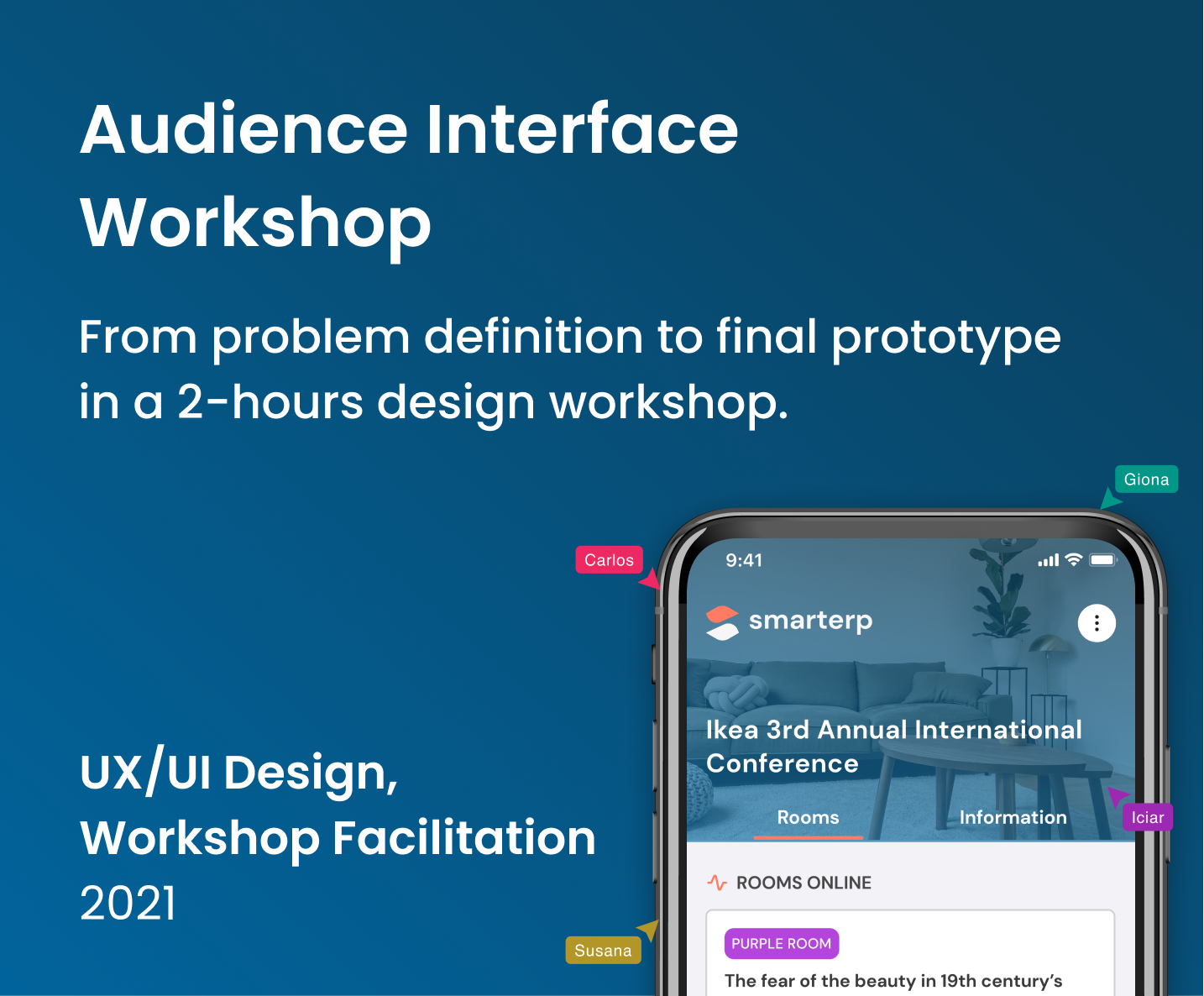
Audience Interface WorkshopUX/UI Design Workshop
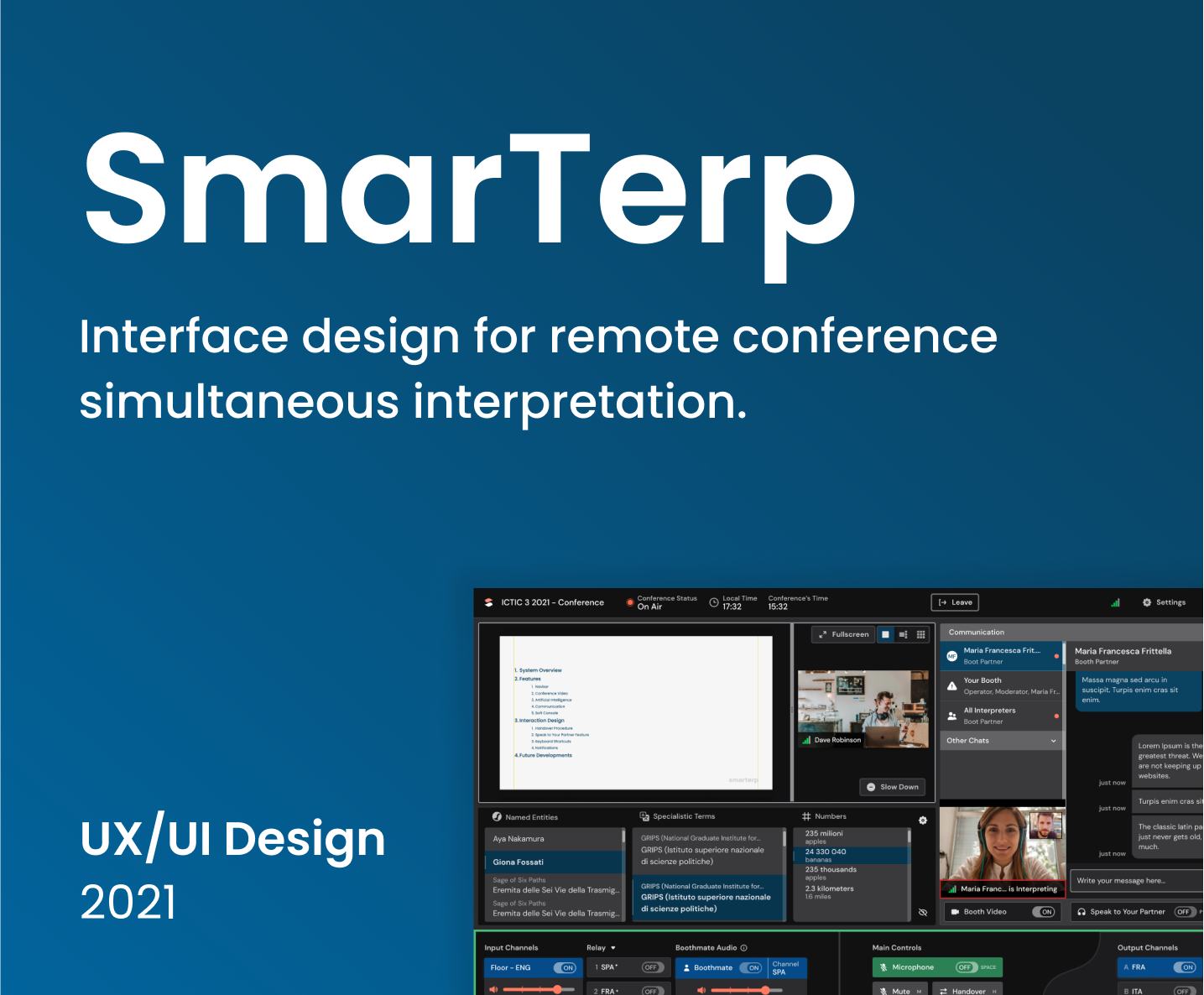
SmarTerp - Simultaneous Interpretation InterfaceProduct Design
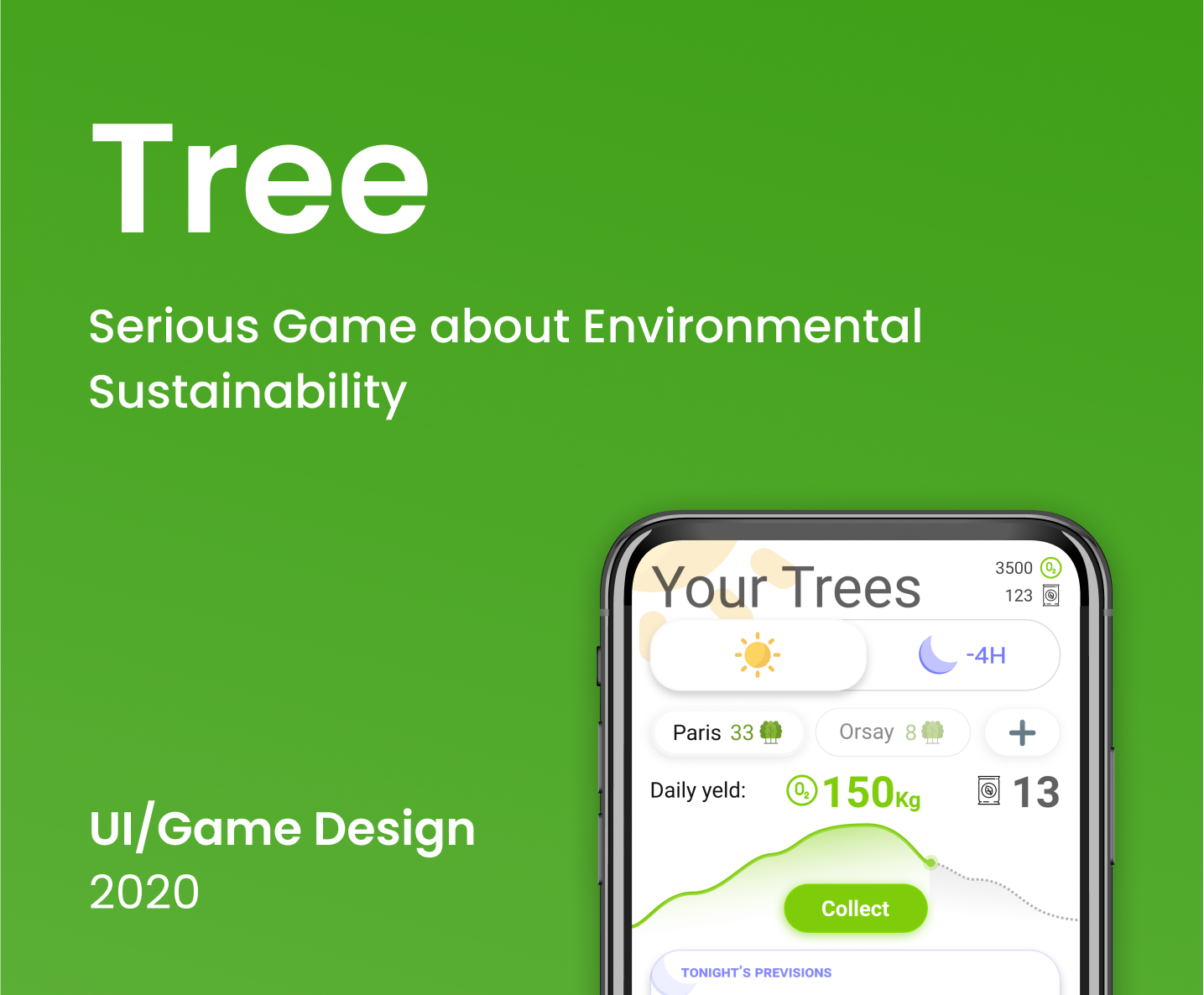
TreeSerious Game
fossatigiona@gmail.com

